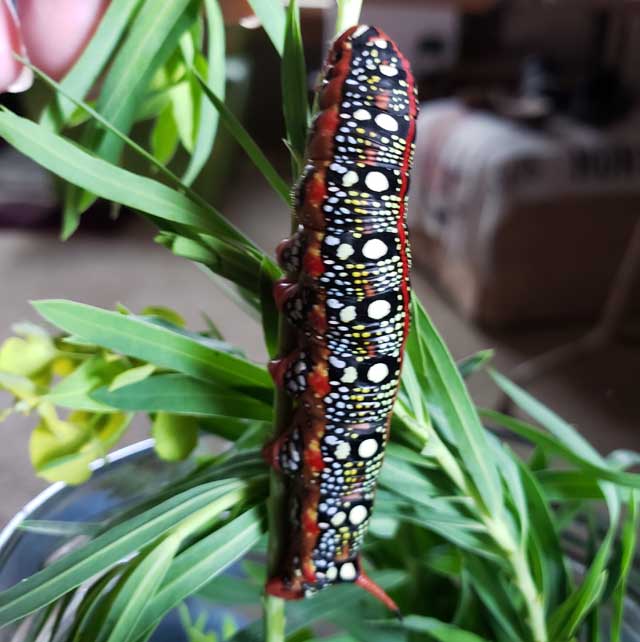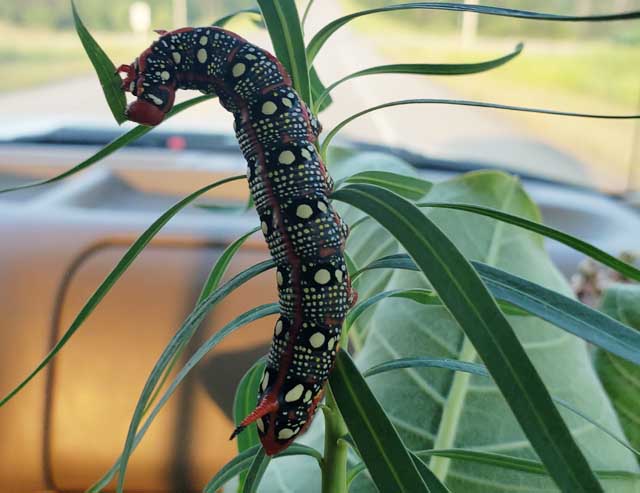Sphinginae subfamily
Sphingini tribe:
 |
Agrius cingulata,
Grand Traverse Pink-spotted hawkmoth,
stray
This species is a strong migrant and adults nectar from
deep-throated flowers including moonflower (Calonyction aculeatum),
morning glory (Convolvulus), honey suckle (Lonicera)
and petunia (Petunia species).
|
 |
Ceratomia amyntor
WO/Grand Traverse,
the Elm Sphinx or Four-horned Sphinx
The upperside of the forewing is brown with dark brown and white
markings including a white costal area near the wing base, dark
streaks along the veins, and a white spot in the cell.
|
 |
Ceratomia undulosa
WO/Benzie/Grand Traverse/Leelanau/Manistee,
the Waved Sphinx
The upperside of the forewing is pale brownish gray with wavy black
and white lines and a black-outlined white cell spot.
|
 |
Dolba hyloeus
WO/Grand Traverse, the Pawpaw Sphinx
The upperside of the forewing is dark brown with a dusting of white
scales. Some moths have patches of reddish or yellowish brown on the
wings. Larve are not limited to pawpaw.
|
 |
Lapara bombycoides
WO/Grand Traverse, the
Northern Pine Sphinx
The upperside of the forewing is gray with heavy black bands. The
upperside of the hindwing is brownish gray with no markings.
|
 |
Lintneria eremitus
WO/Grand Traverse,
the Hermit Sphinx.
The upperside of the forewing is gray-brown with wavy lines, black
dashes, and one or two small white spots near the center of the
costa. The upperside of the hindwing is black with two white bands
and a triangular black patch at the base.
Note the golden hair on the thorax.
|
 |
This large bodied moth flies in tobacco fields and vegetable gardens
(potatoes, tomatoes) and wherever host plants are found.
|
 |
Manduca sexta
Wexford County/Grand Traverse, the Carolina Sphinx
If you grow tomatoes, you may encounter it.
Larvae get very large and can strip a tomato plant.
|

|
Sphinx canadensis
WO,
Sphinx canadensis, the Canadian Sphinx, is not common, and is not
often reported anywhere,
but it might possibly be present in Mackinac County.
Larval hosts are white ash (Fraxinus americana) and blueberry
(Vaccinium).
|
 |
Sphinx chersis
WO/Benzie/Grand Traverse, the Northern Ash
Sphinx or Great Ash Sphinx
The upperside of the forewing is soft dark gray to blue-gray with
a series of black dashes, one of which reaches the wing tip.
|

|
Sphinx drupiferarum
WO/WO/Benzie/Grand Traverse, the Wild Cherry
Sphinx
This species is present in Mackinac County. We have them on P.E.I.,
but I do not see them nearly as frequently as I see the other
Sphingidae.
|
 |
Sphinx kalmiae
WO/Grand Traverse, the Laurel Sphinx
The lower forewings are predominantly brownish-yellow with a fairly
wide dark bar along the inner margin. At rest the wings hug the body,
giving the moth a long slender look.
|
 |
Sphinx luscitiosa
WO/Grand Traverse,
the Canadian Sphinx or
Clemen's Sphinx
The upperside of the forewing is yellowish gray in males and pale
gray with a faint yellow tint in females. In both sexes, the dark
border on the outer margin widens as it approaches the inner margin.
|
 |
Sphinx poecila
WO/Grand Traverse/Leelanau/Manistee, the Poecila Sphinx
If you have blueberries in the woods, then you probably have the
Poecila Sphinx. They are pretty widespread throughout Michigan. |
Smerinthini Tribe:
 |
Amorpha juglandis
WO/Benzie/Grand Traverse,
the Walnut Sphinx
The adults are also highly variable; sometimes wings of an individual
may be all one color or may have several colors, ranging from pale to
dark brown, and may have a white or pink tinge.
|
 |
Pachysphinx modesta
WO/Grand Traverse/Manistee,
the Modest Sphinx or Poplar Sphinx,
This large poplar/willow feeder is reported in Mackinac County.
They are a heavy bodied species.
|
 |
Paonias excaecata
WO/Benzie/Grand Traverse/Leelanau/Manistee, the Blinded Sphinx,
The outer margin of the forewing is quite wavy. There is a dark cell
spot and a dark oblique line mid wing from the costa almost to the
inner margin. Basic ground colour is pinkish brown. Flight would
be June-July. |
 |
Paonias myops Wexford County/Benzie/Grand Traverse/
Leelanau/Manistee,
the Small-eyed Sphinx
This small species is probably widespread and common. This species
ranges across North America.
The hindwings have a small blue eyespot ringed with black on a yellow
background.
|
 |
Smerinthus cerisyi
WO/Grand Traverse, the Cerisyi's
Sphinx or One-eyed Sphinx, Larvae feed on poplars and willows.
Flight would be from late May-July as a single brood. It is
reported in Mackinac.
|
 |
Smerinthus jamaicensis
WO/Benzie/Grand Traverse/Manistee, the
Twin-spotted Sphinx
This moth is widely distributed and fairly common, and it is recorded
in Mackinac.
Along the East Coast, it flies from P.E.I. to Florida.
|
Macroglossinae subfamily
Dilophonotini Tribe:
 |
Hemaris diffinis
WO/Benzie/Grand Traverse/Missaukee, the Snowberry Clearwing or Bumblebee Moth,
The moth flies along forest edges and in meadows, gardens and
brushy fields. Day-flying adults nectar at lantana, dwarf bush honeysuckle,
snowberry, orange hawkweed, thistles, lilac, Canada violet, etc. |
 |
Hemaris gracilis
WO,
The Slender Clearwing or Graceful
Clearwing. Hemaris gracilis is distinguished from
similar species by a pair of red-brown bands on the sides of the
thorax, which varies from green to yellow-green dorsally and
sometimes brown with white underneath.
They have a red abdomen.
|
 |
Hemaris thysbe
WO/Grand Traverse/Missaukee, the Hummingbird Clearwing.
They are widely distributed in the east from P.E.I. to Florida. |
Philampelini Tribe:
Macroglossini Tribe:
 |
Amphion floridensis
WO/Benzie/Grand Traverse, the Nessus Sphinix
This day flier is widely distributed. If you have Virginia Creeper,
you probably have the Nessus Sphinx. Two bright, distinct, narrow
yellow bands are often visible on the abdomen.
|
 |
Darapsa choerilus
WO/Grand Traverse,
the Azalea Sphinx
They are common in New Jersey and common
here on Prince Edward Island.
You will often see this species listed as Darapsa pholus,
especially in older literature. |
 |
Darapsa myron
WO/Grand Traverse, the Virginia Creeper Sphinx or the
Grapevine Sphinx
It is widely reported in southern Michigan and in southern Ontario.
If you have the foodplants indicated in the common names, you probably have this
species nearby. |
 |
Darapsa versicolor
WO/Grand Traverse,
the Hydrangea Sphinx
If you have hydrangea growing near a stream, then you may have the
Hydrangea Sphinx. However, it
probably is uncommon.
|
 |
This species has not been recorded in Mackinac.
It is seen in southern Ontario, however, and in central and
southern Michigan. |
 |
Hyles gallii
WO/Grand Traverse, the Bedstraw Hawk Moth
or Gallium Sphinx
Some years I see them on P.E.I., some years, I do not.
|
 |
Hyles lineata WO/Benzie/Leelanau, the White-lined Sphinx
Adults usually fly at dusk, during the night, and at dawn, but they
also fly during the day over a wide variety of open habitats
including deserts, suburbs, and gardens. |
 |
Sphecodina abbottii
WO/Grand Traverse, the Abbott's Sphinx
This moth is very much under reported on USGS. It is a
rapid day flier so is probably not in too many collections.
Grape is a popular larval host.
|
|
|



